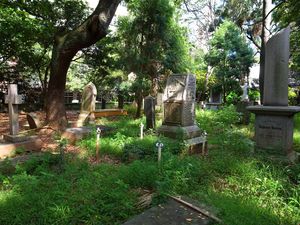淡水外僑墓園/Tamsui Foreigners' Cemetery
Introduction[編輯]
Tamsui Foreigners' Cemetery was situated at Alley 3, Zhenli Street. It’s a cemetery for foreigners who died in Taiwan in the 19th century. Separated from Mackay Cemetery only by a wall, the cemetery was designated as a historic site on August 29, 1998. After the port in Tamsui was opened to commerce in 1860, it became an international port. The Qing Government also allowed those foreigners who came to Tamsui to do missionary work, reside, purchase real estates, and be buried there. Therefore many foreigners who died in Tamsui were buried there.
The earliest tomb in the Cemetery was built in 1867. The British Embassy started to take charge of the Cemetery in 1890. As the official documents were pigeonholed for quite some time, the British Embassy did not have the account book for the Cemetery until 1890. The first record of the book was a £208 donation from the Tamsui Customs. In 1909 Mr. Takashi Shigetaka, the administrator of the British cemeteries and the consular agent of British Embassy, paid one hundred silver dollars to lease the land indefinitely and unconditionally. It has remained such until now. The Cemetery is now managed and maintained by Canadian Society.
Cemetery division and materials[編輯]
Due to the differences of religious beliefs or occupations, the cemetery is divided into four sections: the east end was for Protestants, the west end for business people, the south end for Catholics and the north end for military officers.
The Cemetery mainly used two types of materials. The first type included various stones, such as Guanyinshan stones, granites, Jilian stones, and marbles. Granites were the most popular material. The other primary material was bricks. ~translated by Ai-Ci Jhang
